- For mobile homes without a built-in motor vehicle, see travel trailer.
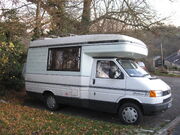
Volkswagen Autosleeper Clubman GL, a typical European campervan
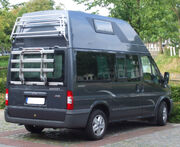
A campervan (or camper van), sometimes referred to simply as a camper, or a caravanette, is a self-propelled vehicle that provides both transport and sleeping accommodation. The term mainly describes vans that have been fitted out, often with a coachbuilt body for use as accommodation. In the United States the term "recreational vehicle" (RV) is more common for these vehicles, and in that country they tend to be larger than in Europe and the rest of the world.
Ambiguity with Motorhome[]
The term motorhome is sometimes used interchangeably with campervan, but the former can also be a larger vehicle than a campervan and intended to be more comfortable, whilst the latter is more concerned with ease of movement and lower cost.[1] For example, campervans generally lack built-in toilets and showers, or a divide between the living compartment and the cab.[2]
Features[]
Campervans may be equipped either with a "pop-up" roof which is raised during camping or a fixed roof, either shared with the commercial van that forms the basis of the vehicle (commonly a "high-top" model), or as part of a custom coachbuilt body.
Campervans usually have a small kitchen with a refrigerator (which is often powerable by a choice of gas, battery, or mains electricity) and a two-burner gas hob and grill. They generally have dual-voltage lighting which can work from either a dedicated battery (other than the van battery) known as a deep-cycle or leisure battery, or from AC power, supplied at a campsite via a hook-up cable. Larger models may include a water heater, space heating and air conditioning, a portable toilet and even an internal shower. Smaller models often carry a "porta-potty" portable toilet, and sometimes an external shower which operates within the privacy of an awning.
The term "Dormobile" is sometimes used generically in the United Kingdom thanks to a once highly popular conversion brand, and "Kombi" is used in Australia and other countries. The popularity of this type expanded in the 1950s after Volkswagen commissioned the Westfalia company to use the Kombi version of their Type 2 transporter as the basis for a campervan.
Off-road variations[]
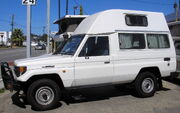
Toyota Landcruiser 4WD camper
Pop-up roof variants share certain design elements with roof tents as sometimes fitted to more robust four wheel drive off-road vehicles intended for expeditions rather than relaxed camping. A compromise between these two worlds is sometimes reached by basing the conversion on an off-road vehicle. Sometimes the conversion is demountable from the back of a pick-up truck body.
Classic Volkswagen campervans[]

Classic Volkswagen Camper
- Main article: Volkswagen Westfalia Campers
There are several types of campervan all manufactured by Volkswagen but depending on their age they are colloquially referred to as either a splitty (split windscreen) a bay (bay framed windscreen) or a bricky ("brick" shaped van).
Although less popular, Mercedes also manufactured a similar-sized light van and conversions were reasonably common in the 1960s and '70s. Of a similar size and vintage is the British Commer Spacevan conversion.
Modern mid-sized Japanese vans such as the Toyota Hiace are sometimes converted to have the appearance of a classic Volkswagen.
British and European size and type classifications[]
A-class (AC)[]
Similar to North American A-class recreational vehicles (sometimes known generically as "Winnebagos") but generally still smaller in Europe. Fully coachbuilt over a medium-to-large van chassis, from 7.5 tonnes and upwards. Highly appointed, sometimes with electrically-operated slide-out (sideways) extensions to the living space, electricity-generating windmills and in very large models (of North American scale) sometimes even fitted with a hydraulically operated garage capable of transporting a small car.
Overcab (OC)[]
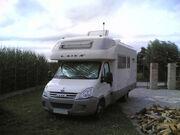
Typical "overcab" camper on a relatively large Iveco van base
Coachbuilt body, usually but not always retaining the base van's cab, with a raised Luton van style area over the cab containing a bed. Other beds may be fixed in place, built by moving seats and tables, or lowered from the ceiling. Shower and toilet cubicles usually fitted. Sometimes including a garage for bikes, and may be large enough to support a mechanism for towing a small city car. Roughly comparable to the North American C-class (CC).
Common base vehicles include the Fiat Ducato, Renault Master, and Ford Transit.
Low profile (LP)[]
Coachbuilt but without a raised bed over the cab. Other beds may be fixed in place, built by moving seats and tables, or lowered from the ceiling. Shower and toilet cubicles usually fitted. Garages and towing fittings may be carried as with the overcab designs.
Typical base vehicles are lighter-duty and/or smaller-engined variants of the same vehicles used for overcab designs.
High top (HT)[]
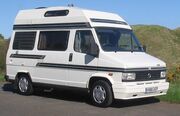
Autosleeper Harmony "high top" Campervan
Based on a high-top van, typically of around 2.8 to 4.5 tonnes gross vehicle weight, without major coachbuilding modifications to the body. Beds typically fixed in place or built by moving seats and tables. Shower and toilet cubicles sometimes fitted.
Typical base vehicles are the same as for the coachbuilt designs, above.
Rising roof (RR)[]
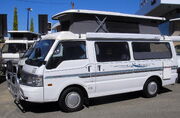
Mazda "rising roof" campervan
Often based on a relatively small van, typically 2 to 3 tonnes gross vehicle weight, including the classic Volkswagen Type 2, and with a roof which raises, usually with fabric sides, in a way not unlike a roof tent. Bed typically in the rising roof but also sometimes built by moving seats and tables. Shower and toilet cubicles rarely fitted.
The Volkswagen Transporter is a common base vehicle, and Ford Transits are also reasonably common.
Fixed roof (FR)[]
Also known as "surf vans" (or "surf buses") and "day vans". Typically similar in size to the rising roof designs. Beds usually built by moving seats and tables. Shower and toilet cubicles very rarely fitted.
The Volkswagen Transporter and Mercedes-Benz Vito are particularly common base vehicles. They have become the successors to the classic Volkswagen Type 2. Slightly smaller vans such as the Fiat Scudo may be used; on occasion, even smaller vans such as the Fiat Doblò are used to make casual light-duty campers with minimal facilities beyond sleeping space.
Dismountable (DM)[]
A coachbuilt body sits on a (sometimes modified) pick-up load-bed, and generally removable at campsites to allow the vehicle to be used.
Ford, Toyota, and Mitsubishi vehicles are common bases.
Conversion kits (Kit Cars)[]
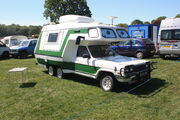
Campervan conversion/kit based on Ford Cortina car components
A Type that was available in the early 1980's was a selfbuild kit similar to a kit car in which a donor vehicle provided the mechanical running gear for the owner to build into a factory built glassfibre shell and thow bulder fitted out the interior as well to their own spec.
B-class (BC)[]
This term is not commonly used except for imported North American models, which may vary greatly in size from semi-low profile coachbuilts to van conversions.
North American van conversions[]
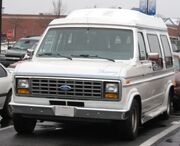
Ford Econoline van conversion
- Main article: recreational vehicle
In North America there are many manufacturers of campervans. A well-selling campervan is produced by Roadtrek of Kitchener, Ontario.[3]
Since the 1970s, Japanese vans like the Toyota Hiace and the Datsun Urvan, as well as European models based on the Ford Transit, Fiat Ducato and Bedford vans have become popular as base vehicles for conversions.
Amenities[]
A modern campervan may contain some or all of the following features:
- Gas/electric powered refrigerator
- Gas/electric grill
- Microwave
- Gas/electric powered water heater
- One or more beds, some of which double-up as daytime seating
- Electricity supplied by leisure battery or external hook-up
- Cassette Toilet with removable disposal tank
A flushing toilet with access usually outside the campervan for easy emptying. Some models have a swivel system for extra space.[4]
- Shower
- Television (with aerial and/or satellite dish)
- Air conditioning (at least the normal vehicle's cab system)
- Water tank
- Wastewater tank for "grey" (wash) water
- Extendable external Awning
An extendable canvas shade which offers protection from the sun. [5]
- Bike rack
A carrying device for bicycles, usually fixed to the rear of the campervan.[6]
See also[]
- Caravan park
- Conversion van
- Travel trailer
- Motorhome
References[]
- ↑ <"Campervans and motorhomes". Campervan Adventures.
- ↑ "What are the Differences Between a Campervan and a Motorhome?". Discovery Homes New Zealand.
- ↑ History of Roadtrek Motorhomes (formerly Home & Park Motorhomes)
- ↑ "Campervan Glossary". Motorhome Group.
- ↑ "Campervan Glossary". Motorhome Group.
- ↑ "Campervan Glossary". Motorhome Group.
| This page uses some content from Wikipedia. The original article was at Campervan. The list of authors can be seen in the page history. As with Tractor & Construction Plant Wiki, the text of Wikipedia is available under the Creative Commons by Attribution License and/or GNU Free Documentation License. Please check page history for when the original article was copied to Wikia |